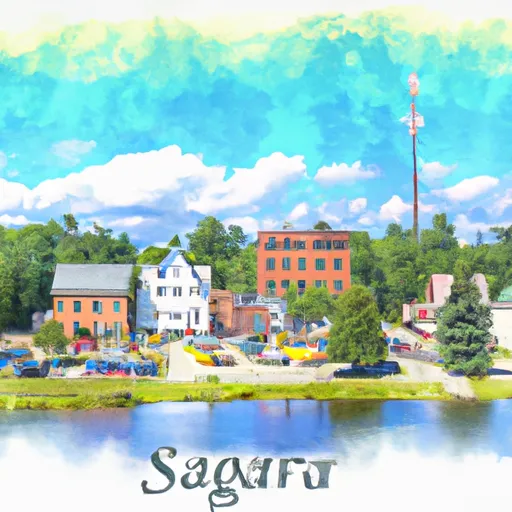-
 Snoflo Premium
Snoflo Premium
Get unlimited access to all our content
With no Ad interruptions! - Start Your Free Trial Login with existing account
Saranac
Eden Index
Climate
7.1
•
Recreation
4.1
•
Community
1.8
•
Safeguard
4.7/10

Saranac, Michigan is a small village located in Ionia County, in the central part of the state. The village experiences a humid continental climate, characterized by warm summers and cold winters. Average high temperatures in the summer range from the mid-70s to low 80s Fahrenheit, while winter temperatures average in the mid-30s to low 20s. Precipitation is fairly evenly distributed throughout the year.
Saranac is surrounded by numerous lakes and rivers, making it a great place for outdoor enthusiasts. The Grand River, one of Michigan's longest rivers, flows just a few miles west of the village. This provides opportunities for boating, fishing, and kayaking. Additionally, there are several smaller lakes in the area, including Morrison Lake, Sessions Lake, and Jordan Lake, which offer further recreational activities such as swimming, water skiing, and hiking along their shores.
The region's hydrology is also influenced by wetlands, streams, and creeks, which contribute to the overall ecosystem and provide habitat for a variety of wildlife. Saranac's natural surroundings offer a pleasant environment for outdoor enthusiasts to explore and enjoy various recreational activities.
What is the Eden Index?
The Snoflo Eden Index serves as a comprehensive rating system for regions, evaluating their desirability through a holistic assessment of climate health, outdoor recreation opportunities, and natural disaster risk, acknowledging the profound impact of these factors on livability and well-being.
Climate Health Indicator (CHI): 7.1
Saranac receives approximately
918mm of rain per year,
with humidity levels near 82%
and air temperatures averaging around
9°C.
Saranac has a plant hardyness factor of
5, meaning
plants and agriculture in this region thrive during a short period during spring and early summer. Most
plants will die off during the colder winter months.
By considering the ideal temperature range, reliable water supplies, clean air, and stable seasonal rain or snowpacks, the Climate Health Indicator (CHI) underscores the significance of a healthy climate as the foundation for quality living.
A healthy climate is paramount for ensuring a high quality of life and livability in a region, fostering both physical well-being and environmental harmony. This can be characterized by ideal temperatures, reliable access to water supplies, clean air, and consistent seasonal rain or snowpacks.
Weather Forecast
Streamflow Conditions
Southeastern Lake Michigan
Area Rivers
Southeastern Lake Michigan
Snowpack Depths
Southeastern Lake Michigan
Reservoir Storage Capacity
Southeastern Lake Michigan
Groundwater Levels
Recreational Opportunity Index (ROI): 4.1
The Recreational Opportunity Index (ROI) recognizes the value of outdoor recreational options, such as parks, hiking trails, camping sites, and fishing spots, while acknowledging that climate plays a pivotal role in ensuring the comfort and consistency of these experiences.
Access to outdoor recreational opportunities, encompassing activities such as parks, hiking, camping, and fishing, is crucial for overall well-being, and the climate plays a pivotal role in enabling and enhancing these experiences, ensuring that individuals can engage in nature-based activities comfortably and consistently.
Camping Areas
| Campground | Campsites | Reservations | Toilets | Showers | Elevation |
|---|---|---|---|---|---|
| Johnny Appleseed Park | 40 | 759 ft | |||
| Cade Lake County Park | 62 | 869 ft | |||
| Pigeon River State Fish and Wildlife Area | 45 | 911 ft | |||
| Chain OLakes State Park | 410 | 956 ft | |||
| Ouabache State Park | 125 | 822 ft | |||
| Pokagon State Park | 275 | 1,026 ft | |||
| Memorial Park Campground - Coldwater | None | 927 ft | |||
| Bixler Lake City Campground | 100 | 965 ft | |||
| Hidden Diamonds City Park | None | 901 ft | |||
| Steuben County Park | None | 1,019 ft |
Nearby Ski Areas
Catastrophe Safeguard Index (CSI):
The Catastrophe Safeguard Index (CSI) recognizes that natural disaster risk, encompassing floods, fires, hurricanes, and tornadoes, can drastically affect safety and the overall appeal of an area.
The level of natural disaster risk in a region significantly affects safety and the overall livability, with climate change amplifying these risks by potentially increasing the frequency and intensity of events like floods, fires, hurricanes, and tornadoes, thereby posing substantial challenges to community resilience and well-being.
Community Resilience Indicator (CRI): 1.8
The Community Resilience Indicator (CRI) recognizes that education, healthcare, and socioeconomics are crucial to the well-being of a region. The CRI acknowledges the profound impact of these elements on residents' overall quality of life. By evaluating educational resources, healthcare accessibility, and economic inclusivity, the index captures the essential aspects that contribute to a thriving community, fostering resident satisfaction, equity, and social cohesion.

